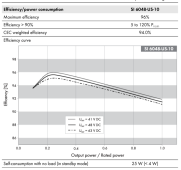I have one 330W panel.
I ordered another 2.
My 100Ah battery will not take.... rather, I do not want to throw all 1000W at it.
Similarly I can't increase the load side too much to reduce the amount of "excess solar" going to the battery because the moment the sun goes back in behind the clouds the battery takes a discharge pounding. I'd rather not have to introduce dynamic "bleed loads" either as they are typical just wasting power resistatively.
So I need to current limit the panels. My present MPPT (EPEver 4210AN) does not support current limiting period, except as part of "top of charge tapering". It will supply up to 40A charge current, or 1000W which ever is first.
Solution 1. Just connect all 3 in parallel to the EPEver I have. Let it limit at 40A. It will accept the over-panelling up to 1500W. Accept the higher wear and tear on the battery. Increase the daytime loads and interactively run other loads from teh solar circuit when it's sunny. Micro manage it for a few months.
Solution 2. Same as above, but leave one of the panels disconnected entirely. This will supply 20A or 700W max. Of course this is unsatisfactory as in Ireland the panels spents the majority of its time running nowhere near peak output and so by leaving a panel disconnected I waste 1/3rd of my low light output.
Solution 3. I purchased a Victron MPPT 75/15 Smartsolar. I can connect two panels to it to limit the pair to 15A bringing the total panel current down to 25A. Unfortunately this approach alone only drops 5A off the total and still results in over 30A charge currents.
Solution 4. Hope the additional current limiting features work in the SmartSolar and limit the pair of panels to 10A rather than 15A. This would bring the maximum power point output into managible range and still give me the best low light performance from all 3 panels.
The battery upgrade will depend on whether I wait longer and invest bigger or just duplicate/double up what I have, which I can afford a lot sooner. Even if I choose the later and order them next week, the will not arrive to go into service until August or September. So whatever I do has to be managable until then.
I ordered another 2.
My 100Ah battery will not take.... rather, I do not want to throw all 1000W at it.
Similarly I can't increase the load side too much to reduce the amount of "excess solar" going to the battery because the moment the sun goes back in behind the clouds the battery takes a discharge pounding. I'd rather not have to introduce dynamic "bleed loads" either as they are typical just wasting power resistatively.
So I need to current limit the panels. My present MPPT (EPEver 4210AN) does not support current limiting period, except as part of "top of charge tapering". It will supply up to 40A charge current, or 1000W which ever is first.
Solution 1. Just connect all 3 in parallel to the EPEver I have. Let it limit at 40A. It will accept the over-panelling up to 1500W. Accept the higher wear and tear on the battery. Increase the daytime loads and interactively run other loads from teh solar circuit when it's sunny. Micro manage it for a few months.
Solution 2. Same as above, but leave one of the panels disconnected entirely. This will supply 20A or 700W max. Of course this is unsatisfactory as in Ireland the panels spents the majority of its time running nowhere near peak output and so by leaving a panel disconnected I waste 1/3rd of my low light output.
Solution 3. I purchased a Victron MPPT 75/15 Smartsolar. I can connect two panels to it to limit the pair to 15A bringing the total panel current down to 25A. Unfortunately this approach alone only drops 5A off the total and still results in over 30A charge currents.
Solution 4. Hope the additional current limiting features work in the SmartSolar and limit the pair of panels to 10A rather than 15A. This would bring the maximum power point output into managible range and still give me the best low light performance from all 3 panels.
The battery upgrade will depend on whether I wait longer and invest bigger or just duplicate/double up what I have, which I can afford a lot sooner. Even if I choose the later and order them next week, the will not arrive to go into service until August or September. So whatever I do has to be managable until then.






